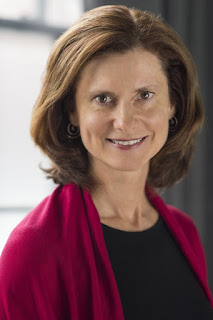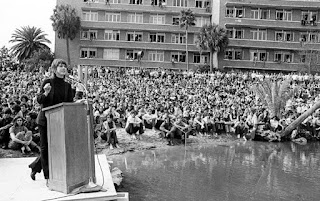Author Tina Egnoski writes poetry and fiction. Her first novel, Burn Down This World, came out this year from Adelaide Books. She is a native of Florida and now lives in Rhode Island where she works in the Liberal Arts Division at the Rhode Island School of Design.
Tina talked with Rose City Reader about Burn Down This World, what inspires her, and books she loves:
How did you come to write Burn Down this World?
I blame it on Jane Fonda! Seriously. But first, let me step back and give you a quick overview of the book. It centers on Celeste and Reid Leahy, siblings raised in a military family who come-of-age in the South in the late 1960s, at the height of social change and national unrest over the Vietnam War. As students at the University of Florida in the early 1970s, they’re active in antiwar demonstrations. Those activities, which begin as peaceful and soon turn violent, eventually tear the sister and brother apart. The braided narrative tells the story of their history, as well as their reunion after years of estrangement.
The events of the novel were inspired by real anti-Vietnam War demonstrations that took place at the University of Florida in May of 1972. I’m an alumna of the university, although I didn’t attend during the time of the protests. I did, however, work for a time in the university archives.
Now, here’s the Jane Fonda connection. While working in the Photograph Collection, I found a picture of her giving an antiwar speech on campus in 1971. She’s at a podium on a wooden platform at Graham Pond. Students are crowding around the pond and, in the background, many are hanging out of dorm windows. I was fascinated by that picture. It stuck with me. Years later, when I decided to write about student activism, the picture was readily available online. I used it as a jumping-off point.
You describe the story as having a "braided narrative." Describe what you mean.
A braided narrative is typically a structure with two or more plotlines interwoven throughout story. This structure allowed me to move between what I call the “present tense” of the story—when Celeste and brother reunite in 1998—and the past tense of the story—the year they spent together in college. The timelines run parallel and each story informs the other. It can be a challenging structure—a bit of a balancing act. I had to give the reader just enough information in each storyline to keep her/him engaged without revealing too soon the twists-and-turns so pivotal to the plot.
Both story lines take place in Florida, one at the University of Florida in 1971-72 and one during the wildfires of 1998. What drew you to these settings for your novel?
Both settings are ripe for drama. While I wasn’t living in Florida in 1998, my mother was. I experience the wildfires through my daily telephone conversations with her and news reports she shared. She did finally have to evacuate. I was lucky to have a sister who lived close by could assist her with that process. It was a scary time, with so many lives, homes, and businesses danger.
In terms of the early 1970s, that time period was futile ground, and not only because of Vietnam War protests. So much was happening. At the University of Florida that academic year, the first African American student body president was elected and the student newspaper was kicked off campus for publishing a list of abortion clinics. I simply couldn’t write about it all. I tried, but the narrative became overrun with subplots. I had to narrow my focus to the protests.
Tell us why you gave Jim Morrison from the Doors a cameo in your new book.
Music is such a powerful connector of people. I knew early in the writing process that the music of the 60s and early 70s would be an important backdrop. The Rolling Stones, Creedence Clearwater Revival, Santana, The Doors: these were iconic rock bands of the time. You can’t think of Crosby, Stills, Nash & Young without thinking of the song “Ohio.”
As for Jim Morrison, well, he and I do share a birthplace. I couldn’t let that personal tidbit go unmentioned. Aside from that, I loved the idea that for Celeste music isn’t just background. Her love of The Doors brings her closer to her brother at an otherwise contentious time in their lives.
What is your background? How did it lead you to writing books?
I began writing at a young age. When I was in my teens, I wrote very, very, very bad love poetry. In high school, I appeared to be industriously taking notes while my teachers lectured, but really I was writing poetry. Everyone assumed I was a diligent student. In reality, I was a daydreamer, more interested in the language and structure of poetry than history or algebra or biology. I turned to fiction while in college.
I studying writing at Emerson College. It was in that program that I began the novel, but in a much different form. It was about Celeste and Reid and their estrangement, but I hadn’t yet figured out the cause. I set it aside for several years. In that time, I had a son and wrote three other books. Then, in 2013 I rediscovered that picture of Jane Fonda and knew I had found the heart of my story.
Who are your three (or four or five) favorite authors? Is your own writing influenced by the authors you read?
There are number of writers who have influenced my writing. In terms of classics, I love James Baldwin, the Brontë sisters, Zora Neale Hurston, Fitzgerald, Flaubert, Toni Morrison, and Edith Wharton. I also write short stories, so I admired short fiction writers like John Cheever, Lauren Groff, Flannery O’Conner, and Alice Monroe.
The one book I re-read every few years is Erica Jong’s Fear of Flying. The reason I love that book so much is because it was one of the first books I read that spoke frankly and from a feminist point of view about love, sex, family, family dysfunction, politics, psychotherapy, literature, and religion. In other words—it has it all!
What kind of books do you like to read? What are you reading now?
I love contemporary literary fiction. Authors I read and admire include Chimamanda Ngozi Adichie, Tracy Chevalier, Karen Joy Fowler, Ian McEwan, Claire Messud, and Zadie Smith.
Recently, I finished The Snakes by Sadie Jones and The Most Fun We Ever Had by Claire Lombardo. Two of the best books I read in 2019. Both are well-written, engaging, with meaty family dysfunction at the center. And what’s better in fiction than a messy family saga?
What is the most valuable advice you’ve been given as an author?
Perfection kills creativity. It’s been said many times, many ways, and it’s true. I have to battle perfectionism with every piece I write. I’ve also had to learn when to let go and send out a story. No creative endeavor is ever going to be perfect. When I deem it “good enough”—and that’s a tricky judgement call—I let it go by submitting it to a journal or press.
What’s next? Are you working on your next book?
I’m working on a collection of short fiction. The stories are historical in nature and focused on writers who have a connection to Florida. For instance, I read recently about the poet Edna St. Vincent Millay and a trip she took to South Florida in 1936. After checking into a hotel on Sanibel Island, she walked down to the beach. Just as she hit the sand, the hotel caught fire. She lost the only copy of a manuscript she was working on. She was able to rewrite the manuscript from memory and the book, Conversation at Midnight, was published in 1937. That’s the kind of fact I love to turn into fiction.
THANKS, TINA!
BURN DOWN THIS WORLD IS AVAILABLE ONLINE IN PAPERBACK AND E-BOOK.



